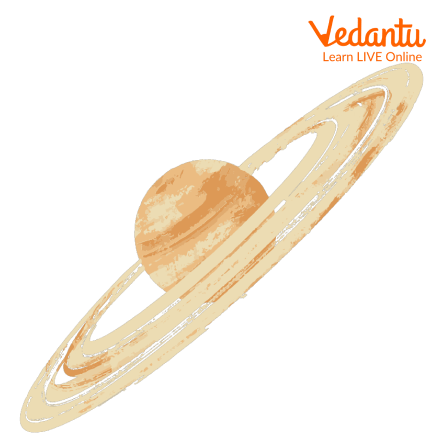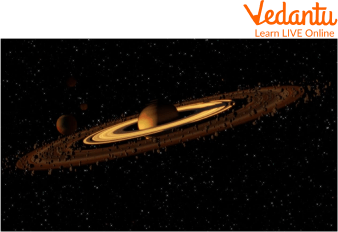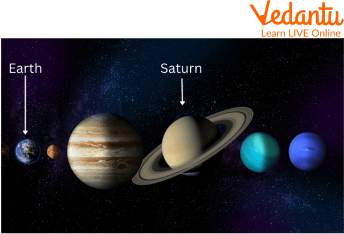




Why Saturn Planet Matters: Quick Guide for Students
We can better understand the planets and other small planetary bodies in our solar system by learning more about how it was formed, how they got to their current diverse state, how life developed on Earth and perhaps elsewhere in the solar system, and what features of the solar system led to the origins of life.
The second-largest planet in the Solar System after Jupiter, Saturn is the sixth planet from the Sun. The fact that Saturn has 82 moons—more than any other planet—makes it the king of the moons. So let’s hop on to read more about this ringed planet and some information on the wind speed of Saturn.
Saturn - The Second Largest Planet
The second-largest planet in our solar system, Saturn, is located at a distance of six planets from the Sun. Saturn stands out among the planets due to its countless lovely ringlets. While there are other planets with rings composed of ice and rock pieces, none are as magnificent or intricate as Saturn's.
Saturn, a gas giant like Jupiter, is a large globe primarily composed of hydrogen and helium. With only around one-third of Jupiter's mass and the lowest mean density of any known object in the solar system—roughly 70% of that of water—Saturn takes up almost 60% of Jupiter's volume.

Saturn the Ringed Planet
Rings of Saturn
The pieces of comets, asteroids, or shattered moons that broke apart before they reached the planet and were torn apart by Saturn's strong gravity are thought to make up the planet's rings. They are made up of endless quantities of tiny pieces of rock and ice that have been coated with other substances. The majority of the ring material is made up of dust-sized ice grains and pieces the size of houses. Some of the particles are the size of mountains. From Saturn's cloud tops, the rings would appear mostly white, and interestingly, each ring orbits the planet at a distinct speed.
Possibility of Life On Saturn
The atmosphere of Saturn is unfriendly to life as we know it. Most likely, creatures cannot adapt to the severe and volatile temperatures, pressures, and materials that make up this planet. While the planet Saturn is not a likely environment for life to exist, this is not always the case for all of its several moons. Life might be able to exist on satellites with interior oceans like Titan and Enceladus.
Measurement and Distance of Saturn
Saturn is nine times wider than Earth, with a radius of 36,183.7 miles (58,232 kilometres). Saturn would be roughly the size of a volleyball if Earth were the size of a nickel. Saturn is 9.5 astronomical units from the Sun, about 886 million miles (1.4 billion kilometres), on average. The distance between the Sun and Earth is one astronomical unit or AU. Sunlight travels from the Sun to Saturn at this distance in 80 minutes.
Moons of Saturn
There are countless fascinating and unusual worlds on Saturn. Each of Saturn's moons provides a distinct viewpoint on the Saturn system, from the hazy surface of Titan to the crater-filled Phoebe. Saturn now has 53 confirmed moons, and 29 more are probable moons that are undergoing confirmation.

Saturn and Its Moon
Facts About Saturn Planet
Some interesting facts about Saturn are as follows.
If nine Earths were placed side by side, they would practically fill Saturn. The rings of Saturn are excluded from this.

Earth Compared to Saturn
Saturn takes 29 Earth years to orbit the sun and 10.7 hours (exact time unknown) to rotate once on its axis.
Saturn lacks a solid surface similar to Earth's since it is a gas-giant planet. However, somewhere inside there might be a strong core.
Helium and hydrogen (H2) make up the majority of the atmosphere of Saturn (He).
Saturn has 82 moons in total, including 53 that are known to exist and another 29 that are still awaiting confirmation of their existence.
The most impressive ring system is seen on Saturn, which includes seven rings as well as numerous gaps and splits between them.
Although Saturn cannot host life as we know it, some of Saturn's moons may be able to.
Two tonnes or so of Saturn's mass originated from Earth; in 2017, the Cassini spacecraft was purposefully destroyed in Saturn's atmosphere.
Facts About Saturn Wind Speed for Kids
Near Saturn's equator, winds in its upper atmosphere can travel as fast as 1,800 kilometres (1,118 miles) per hour. The highest speed of the greatest hurricane-force winds on Earth, in contrast, is approximately 396 km/h (246 mph). The yellow and gold bands that are seen in Saturn's atmosphere are caused by these extremely rapid winds and heat rising from the planet's interior.
Saturn's magnetic field is affected by atmospheric winds travelling at speeds of more than 7,000 kilometres per hour, which explains why spacecraft have recorded changes in a day on the planet's surface.
Summary
In this article, we have learnt about the ringed planet Saturn, its moons, the possibility of life, facts and some information on the wind speed of Saturn. At nearly 900 million kilometres, Saturn is almost twice as far from the Sun as Jupiter. Only Jupiter is bigger than Saturn in terms of size in our solar system, although Saturn has a significantly lower mass. Saturn would float on water because its specific gravity is lower than that of water. Similar to Jupiter, Saturn also rotates quite quickly, finishing one rotation in around 10 hours. We hope you enjoyed reading this article, in case of any other doubts feel free to ask in the comments.
FAQs on Fascinating Facts About Saturn Planet
1. What are Saturn's rings made of?
The rings of Saturn are composed of many small, icy fragments. They range in size from gravel-sized particles to house-size objects. There may also be a few larger objects in the rings that look like shepherd moons (Objects in space that fills the gap to keep rings contained). These moons are not gravitational shepherds; they simply orbit Saturn in their orbit around the sun.
2. What makes Saturn so unique?
Saturn stands out among the planets due to its countless lovely ringlets. While there are other planets with rings composed of ice and rock fragments, none are as magnificent or intricate as Saturn's.
3. How thick is Saturn's ring system?
Scientists have determined that the rings may be as thin as 3 feet (1 meter) at their thinnest and as wide as 6 miles (10 kilometres) at their widest.









